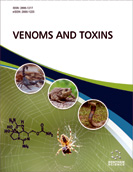Abstract
The scorpion toxins are the largest potassium channel-blocking, peptide family. The understanding of toxin binding interfaces is usually restricted to two classical binding interfaces: one is the toxin α-helix motif, and the other is the antiparallel β-sheet motif. In this review, such traditional knowledge has been updated by another two different binding interfaces: one is BmKTX toxin using the turn motif between the α-helix and antiparallel β-sheet domains as the binding interface, while the other is Tsκ toxin using the turn motif between the β-sheet in the N-terminal and α- helix domains as the binding interface. Their interaction analysis indicated that the scarce, negatively charged residues in the scorpion toxins played a critical role in orientating the toxin binding interface. In view of the toxin, being negatively charged amino acids as a “binding interface regulator”, the law of scorpion toxin-potassium channel interaction was proposed, that is, the polymorphism of negatively charged residue distribution determines the diversity of toxin binding interfaces. Such a law was used to develop the scorpion toxin-potassium channel recognition control technique. According to this technique, three Kv1.3 channel-targeted peptides, using BmKTX as the template, were designed with the distinct binding interfaces from that of BmKTX by modulating the distribution of toxin, negatively charged residues. In view of the potassium channel as the common target of different animal toxins, the proposed law was also shown to adjust the binding interfaces of other animal toxins. The toxin-potassium channel interaction law would strongly accelerate the research and development of different potassium channel-blocking animal toxins in the future.
Keywords: Scorpion toxin, binding interface, interaction law, scorpion toxin-potassium channel recognition control technique, peptide drug design, bee toxin, sea anemone toxin, snail toxin.
Graphical Abstract
[http://dx.doi.org/10.1098/rsbl.2014.0815] [PMID: 25589484]
[http://dx.doi.org/10.1111/j.1475-4983.2007.00749.x]
[http://dx.doi.org/10.1127/njgpm/1990/1990/169]
[PMID: 24470450]
[http://dx.doi.org/10.1002/psc.578] [PMID: 15635623]
[http://dx.doi.org/10.1006/bbrc.1993.1778] [PMID: 8333834]
[http://dx.doi.org/10.1016/j.ijbiomac.2020.01.133] [PMID: 31954123]
[http://dx.doi.org/10.1074/jbc.M115.680611] [PMID: 26817841]
[http://dx.doi.org/10.1038/nature12027] [PMID: 23598338]
[http://dx.doi.org/10.1038/nrn1516] [PMID: 15378036]
[http://dx.doi.org/10.1007/BF02907789]
[http://dx.doi.org/10.1038/296090a0] [PMID: 6278313]
[http://dx.doi.org/10.1016/j.toxicon.2004.03.022] [PMID: 15208019]
[http://dx.doi.org/10.1038/ncomms3602] [PMID: 24129506]
[http://dx.doi.org/10.1042/BJ20041705] [PMID: 15631621]
[http://dx.doi.org/10.1021/bi00149a003] [PMID: 1380828]
[http://dx.doi.org/10.1073/pnas.1000142107] [PMID: 20534430]
[http://dx.doi.org/10.7554/eLife.00594] [PMID: 23705070]
[http://dx.doi.org/10.3390/molecules24112045] [PMID: 31146335]
[http://dx.doi.org/10.1016/j.bbrc.2014.03.101] [PMID: 24704423]
[http://dx.doi.org/10.1021/bi00118a003] [PMID: 1731919]
[http://dx.doi.org/10.1021/bi971044w] [PMID: 9354615]
[http://dx.doi.org/10.1002/(SICI)1097-0134(20000101)38:1<70:AID-PROT8>3.0.CO;2-5] [PMID: 10651040]
[http://dx.doi.org/10.1074/jbc.M802054200] [PMID: 18480054]
[http://dx.doi.org/10.1002/(SICI)1097-0134(199711)29:3<359:AID-PROT9>3.0.CO;2-5] [PMID: 9365990]
[http://dx.doi.org/10.1034/j.1399-3011.1999.00107.x] [PMID: 10563502]
[http://dx.doi.org/10.1021/pr100027k] [PMID: 20405930]
[http://dx.doi.org/10.1080/14712598.2017.1346606] [PMID: 28695745]
[http://dx.doi.org/10.1074/jbc.M112.379594] [PMID: 22761436]
[http://dx.doi.org/10.1038/srep09881] [PMID: 25955787]
[http://dx.doi.org/10.1016/j.neuropharm.2017.11.025] [PMID: 29154773]
[http://dx.doi.org/10.1073/pnas.79.4.1308] [PMID: 6122211]
[http://dx.doi.org/10.1111/j.1432-1033.1991.tb15860.x] [PMID: 2013287]
[http://dx.doi.org/10.1074/jbc.273.1.33] [PMID: 9417043]
[http://dx.doi.org/10.1074/jbc.C900990199] [PMID: 10818087]
[http://dx.doi.org/10.1111/j.1399-3011.1995.tb01068.x] [PMID: 8567178]
[http://dx.doi.org/10.1074/jbc.273.49.32697] [PMID: 9830012]
 26
26 1
1

